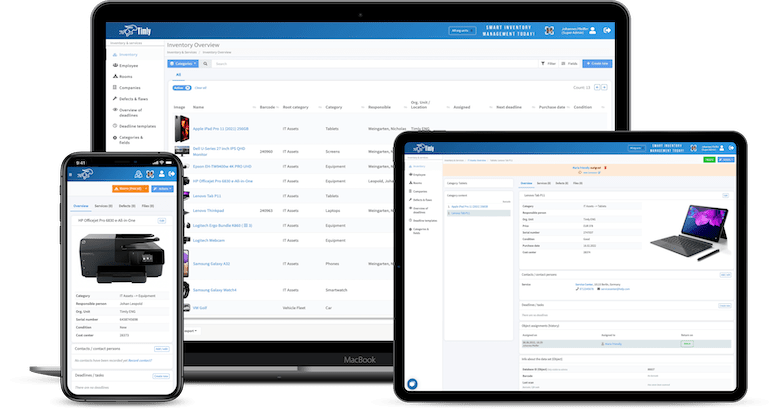Effective Asset Tracking: A Quick 10-Step Guide
Asset tracking is an indispensable part of managing a company’s resources effectively, ensuring that every piece of equipment, from vehicles to machines, is accounted for, utilized efficiently, and maintained properly. Implementing a successful asset tracking system can seem daunting, but with a structured approach, it can significantly boost your operational efficiency and cost savings. Here’s how you can achieve successful asset tracking in 10 strategic steps:
Define Your Objectives
The initial step in establishing a successful asset-tracking system is clearly defining your objectives. This is also the number 1 advice from Timly, a Zurich-based leading provider of Asset Tracking Software. They emphasize that objectives can vary widely depending on the nature of your business, the types of assets you manage, and the challenges you face in asset management. Whether it’s reducing equipment downtime to boost productivity, refining maintenance schedules to extend asset lifespan, enhancing the utilization of assets for optimal ROI, increasing security to prevent loss or theft, ensuring compliance with industry regulations, or aiming for cost reduction by optimizing asset management processes, setting clear goals is crucial. These objectives will guide the selection of tools, technologies, and methods, ensuring your asset tracking system is tailored to meet your specific business needs and challenges effectively.
Inventory Your Assets
Creating a detailed inventory is crucial for establishing an effective asset-tracking system. This involves cataloging every asset in your organization and recording essential details like make, model, purchase date, and current condition. More than just a list, this inventory provides insight into the value and status of each asset, enabling informed decision-making.
For businesses that already maintain asset details in a spreadsheet, choosing an asset tracking software that allows easy importation of this existing inventory is beneficial. Alternatively, entering data directly into the asset tracking software can ensure all relevant information is captured accurately. This step is not just about record-keeping; it’s about setting the stage for efficient asset management, facilitating maintenance scheduling, optimizing asset utilization, and supporting strategic planning.
Categorize Your Assets
Categorizing your assets is a fundamental step toward efficient asset management. A systematic approach to classification allows for easier tracking, management, and reporting. Start by grouping assets based on criteria such as type (vehicles, machinery, technology), location (specific sites or departments), or function (production, service delivery). Utilizing platforms like Timly, you can customize your main categories and create sub-categories, enhancing the organization of your assets intuitively and methodically. This detailed categorization ensures you can quickly locate an item and understand its role in your operations. Such a structured system streamlines asset management tasks and supports better decision-making by providing clear insights into each asset’s usage and performance.

Decide What to Record and Track
With your asset categories defined, the next step is determining the specific data points you’ll collect and maintain for each asset type. Aim to gather as much relevant information as possible to turn your asset-tracking platform into a comprehensive repository of all pertinent details about your assets. Essential data might include serial numbers, warranty details, service histories, and photographs. These elements are crucial for identification, condition assessment, and managing each asset’s lifecycle efficiently. By meticulously deciding on the information to track, you ensure that your asset tracking system is valuable for oversight, decision-making, and operational management, encapsulating a complete view of your asset inventory.
Keep Your Asset Lists Up-to-Date
Maintaining the accuracy of your asset inventory is crucial for effective asset management. As your organization evolves, so will your asset inventory; new acquisitions will be made, assets will be retired or sold, and the condition of existing assets will change. To manage this dynamic environment, it’s essential to establish a robust method for updating your asset lists regularly. Implementing a schedule for periodic reviews and updates of your inventory is a practical approach. This could be monthly, quarterly, or annually, depending on the nature and turnover of your assets.
Assigning specific individuals or teams responsible for these updates ensures accountability and that your asset tracking system always reflects the current state of your assets. Regular updates keep your inventory accurate and provide insights into asset performance, maintenance needs, and lifecycle management. By staying on top of changes and ensuring your asset tracking system is up-to-date, you can make informed decisions, reduce the risk of asset loss, and optimize asset utilization across your organization.
Select Appropriate Technology
Selecting the right technology is pivotal in tailoring an asset-tracking system that meets your needs. The technology you choose should complement your tracking objectives and be suitable for the types of assets you manage. QR codes and RFID tags offer a cost-effective, efficient way to maintain visibility and control for smaller, more mobile items. These technologies are ideal for quick scanning and tracking of assets across various locations, providing real-time data on their status and whereabouts. GPS trackers offer a more robust solution for significant assets like vehicles and heavy machinery. These devices allow for real-time location tracking over vast distances, making them indispensable for managing assets frequently on the move. GPS tracking is particularly beneficial for fleet management, enabling the optimization of routes, monitoring of usage, and enhanced security against theft or misuse.
Choose a Flexible Solution
When selecting technology for asset tracking, consider the context in which your assets are used, the tracking detail required, and the system’s scalability. Your goal should be implementing a solution that meets your current needs and adapts to future changes and growth in your asset inventory. A flexible asset tracking tool is crucial, one that can scale with your business. Initially, you might need a platform offering real-time tracking and maintenance scheduling. Still, future needs could include managing a more significant number of assets or providing access to a more substantial number of users across various departments without incurring extra costs. Select a platform that accommodates these evolving needs, ensuring an efficient, responsive, and cost-effective asset management process over time.
Train Your Team
Adopting your new asset tracking system hinges on practical team training and open communication channels. Start with an overview of the system’s purpose and its operational benefits. Ensure all team members, regardless of their technical skills, can navigate and use the system effectively, highlighting the importance of choosing an intuitive solution like Timely, known for its ease of use. Provide continuous training to cover new features or address challenges and set up clear protocols for issue reporting. This approach ensures your team is well-equipped to maximize the benefits of the asset tracking system.
![]()
Establish a Maintenance Schedule
Leverage the insights from your asset tracking system to create a proactive maintenance schedule. By doing so, you’ll minimize downtime and prolong the life of your assets. This approach ensures operational efficiency and saves costs by avoiding unexpected repairs and replacements. In addition to scheduling maintenance, ensure your tracking practices adhere to industry regulations and standards, maintaining compliance and safeguarding your operations. Protect your asset data from unauthorized access by implementing robust security measures. This dual focus on maintenance and security will keep your assets in prime condition while protecting sensitive information, ensuring your asset management system is practical and secure.
Monitor, Review, Optimize
Utilize the data generated by your asset tracking system to gain insights into asset utilization. Identify underused assets and consider reallocating or disposing of them to streamline your asset portfolio. This process enhances efficiency and potentially reduces costs by eliminating unnecessary assets. Conduct regular reviews of tracking data and user feedback to pinpoint areas where the system’s use could be improved. These reviews might lead to refining maintenance schedules to better align with actual asset usage, revising training programs to ensure all users can fully leverage the system’s capabilities, or even updating the tracking technology to address evolving needs. This cycle of monitoring, reviewing, and optimizing is crucial for maintaining an asset-tracking system that meets and adapts to your organization’s requirements.
Conclusion
Successful asset tracking is not just about installing the latest technology; it’s about integrating it into your operations to meet your business needs. Following these ten steps, you can establish a comprehensive and efficient asset-tracking system that enhances operational efficiency, reduces costs, and improves asset utilization. Remember, asset tracking aims to give you a complete and real-time overview of your assets, empowering you to make informed decisions and strategic investments in your company’s future.






